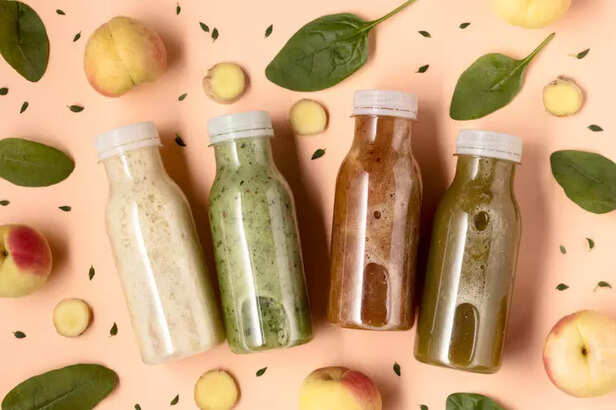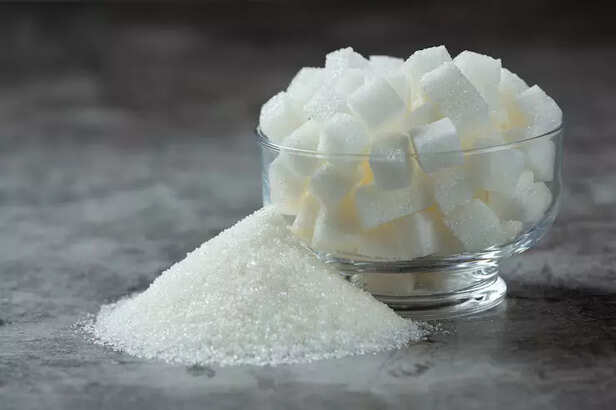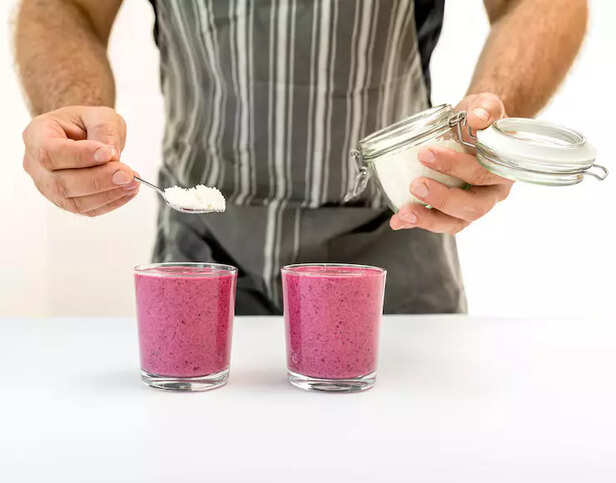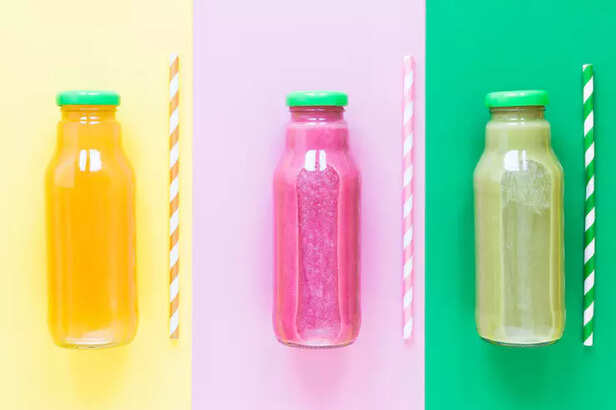Are You Drinking Too Much Sugar in Your Smoothie?
Amritansh Nayak | May 08, 2025, 07:50 IST
( Image credit : Timeslife )
Smoothies from the store, which are frequently marketed as healthy, are loaded with hidden sugars from syrups, sweetened yoghurts, and fruit juices. These sugars raise your risk of type 2 diabetes, cause weight gain, and trigger blood sugar surges. Find out how to prepare low-sugar substitutes.
Smoothies are often marketed as nutritious, convenient, and refreshing. Nevertheless, a lot of store-bought and commercial variants have shockingly high sugar content. These hidden sugars, which range from sweetened yoghurts and syrups to additional fruit juices, can quickly mount up and transform what appears to be a healthy choice into a high-calorie, sugar-filled beverage. These sugary smoothies raise the risk of developing chronic diseases like type 2 diabetes and can cause weight gain and insulin resistance if they are regularly taken. Knowing how much sugar is in your smoothies will help you combine them more intelligently.

Commercial and store-bought smoothies, which are frequently promoted as healthful, can have surprisingly high sugar content. Fruit juices, syrups, and sweetened yoghurts are common ingredients in these smoothies, which raises their sugar content. Although natural sugars are present in fruits like bananas, strawberries, and mangoes, adding juice or flavored yoghurts raises the sugar content considerably—often much more than is required. For instance, the added fruit juices and sweeteners in a typical big smoothie from a chain like Jamba Juice might add up to 50 grammes of sugar. This amounts to approximately 12 teaspoons of sugar, which is far more than the daily allowance that is advised.
Consuming these additional sugars in excess can have detrimental effects on one's health. Consuming too much sugar raises the risk of developing chronic illnesses including type 2 diabetes, heart disease, and even fatty liver disease. It also causes weight gain and insulin resistance. If not properly selected or prepared, a seemingly healthful and pleasant option might quickly turn into a high-sugar beverage. Since many commercial smoothies contain sweeteners that add empty calories without providing any nutritional advantages, it's crucial to review ingredient lists and nutritional labels. This undermines the health objectives that smoothies are supposed to promote.

Fruit, yoghurt, and nut milks are just a few of the often-used ingredients in smoothies that, despite their seemingly healthful appearance, can add unexpectedly high amounts of sugar. Whole fruits provide natural sugars like fructose, but they also contain fiber and other vitamins. Blending concentrates the sugar content, making it easier to ingest in greater amounts. For instance, even before any additional sweeteners are added, a smoothie consisting of two bananas, strawberries, and a handful of mangoes might soon contain 40–50 grammes of sugar. Although yoghurt is frequently seen as a nutritious source of protein, it can also be a secret source of sugar.
Added sugars are used to enhance the flavor of many flavored yoghurts, whether they are dairy or plant-based. Fruit purees or lactose can naturally include sugars, even in unsweetened variants. 15 to 25 grammes of sugar can be added to a smoothie from a regular cup of flavored yoghurt. Nut milks, such as cashew or almond milk, are frequently seen as low-sugar substitutes for dairy. Nevertheless, a lot of store-bought types—especially the sweetened ones—have additional sugars for flavor. You may not even be aware that a cup of sweetened almond milk contains 7–10 grammes of sugar. When these ingredients are combined, a "healthy" smoothie's sugar level can easily surpass daily sugar limitations, compromising its nutritional benefits.

High sugar intake's effects include
Regularly consuming smoothies high in sugar might cause blood sugar levels to rise quickly. Fruit juices, sweetened yoghurt, and syrups are examples of high-sugar foods that instantly raise blood glucose levels when they reach the bloodstream. The hormone insulin, which controls blood sugar, is released as a result. Insulin resistance is a disorder when the body's cells lose their sensitivity to insulin as a result of repeated blood sugar rises. This paves the way for type 2 diabetes, a chronic illness that impacts millions of people globally. Furthermore, a sharp drop in blood sugar frequently follows the brief spike, leaving you feeling drained, agitated, and hankering after more sugar.
Weight gain may result from this cycle, which can also reinforce bad eating patterns. Consuming large amounts of sugar is also associated with increased fat storage, especially around the abdomen, which raises the risk of metabolic disorders such fatty liver disease and heart disease. Regularly ingesting high-sugar smoothies can eventually affect energy levels, interfere with metabolic processes, and compromise general health. When a seemingly healthy beverage overindulges in sugar, especially when ingested frequently, it might do more harm than good.

Making a genuinely healthy smoothie only involves making a few thoughtful decisions; it doesn't imply compromising on taste or nutrients. Start with unsweetened liquids like plain yoghurt, almond milk, or coconut water to make your smoothie low in sugar. These choices offer a creamy mouthfeel and moisture without needless sugar. Next, choose leafy greens such as arugula, spinach, or kale. These nutrient-dense foods are low in sugar and high in fiber, vitamins, and minerals. They will give your smoothie more volume and aid in digestion without raising blood sugar levels. Add a scoop of whey or plant-based protein powder to increase the protein content.
Protein prolongs feelings of fullness and helps control blood sugar levels. Additionally, you may include healthy fats like flaxseeds, chia seeds, or avocado, which help keep you full and slow down the absorption of sugar. Look for low-glycemic fruit, such as half a banana, green apples, or berries. These fruits control their sugar content while offering fiber and antioxidants. A dash of cinnamon or a teaspoon of nut butter can improve flavor without adding more sugar. You may make a smoothie that is nutrient-dense, flavor-balanced, and low in blood sugar by mixing these ingredients.
Cutting back on additional sugars and concentrating on nutrient-dense, low-sugar ingredients is crucial for smoothies to be truly beneficial. To make a well-balanced, invigorating beverage, choose unsweetened liquids, leafy greens, low-glycemic fruits, and healthy fats. You can have a genuinely nutritious smoothie that supports your overall health goals without the hidden sugar problems by making these minor changes.
Explore the latest trends and tips in Health & Fitness, Travel, Life Hacks, Fashion & Beauty, and Relationships at Times Life!

high-sugar smoothies
( Image credit : Timeslife )
The amount of sugar in commercial and store-bought smoothies
Consuming these additional sugars in excess can have detrimental effects on one's health. Consuming too much sugar raises the risk of developing chronic illnesses including type 2 diabetes, heart disease, and even fatty liver disease. It also causes weight gain and insulin resistance. If not properly selected or prepared, a seemingly healthful and pleasant option might quickly turn into a high-sugar beverage. Since many commercial smoothies contain sweeteners that add empty calories without providing any nutritional advantages, it's crucial to review ingredient lists and nutritional labels. This undermines the health objectives that smoothies are supposed to promote.

excessive sugar
( Image credit : Timeslife )
Healthy Smoothie Ingredients: The Hidden Sugars
Added sugars are used to enhance the flavor of many flavored yoghurts, whether they are dairy or plant-based. Fruit purees or lactose can naturally include sugars, even in unsweetened variants. 15 to 25 grammes of sugar can be added to a smoothie from a regular cup of flavored yoghurt. Nut milks, such as cashew or almond milk, are frequently seen as low-sugar substitutes for dairy. Nevertheless, a lot of store-bought types—especially the sweetened ones—have additional sugars for flavor. You may not even be aware that a cup of sweetened almond milk contains 7–10 grammes of sugar. When these ingredients are combined, a "healthy" smoothie's sugar level can easily surpass daily sugar limitations, compromising its nutritional benefits.

high sugar intake
( Image credit : Timeslife )
High sugar intake's effects include blood sugar
Weight gain may result from this cycle, which can also reinforce bad eating patterns. Consuming large amounts of sugar is also associated with increased fat storage, especially around the abdomen, which raises the risk of metabolic disorders such fatty liver disease and heart disease. Regularly ingesting high-sugar smoothies can eventually affect energy levels, interfere with metabolic processes, and compromise general health. When a seemingly healthy beverage overindulges in sugar, especially when ingested frequently, it might do more harm than good.

low sugar smoothies
( Image credit : Timeslife )
Low-Sugar Substitutes for a Totally Healthful Smoothie
Protein prolongs feelings of fullness and helps control blood sugar levels. Additionally, you may include healthy fats like flaxseeds, chia seeds, or avocado, which help keep you full and slow down the absorption of sugar. Look for low-glycemic fruit, such as half a banana, green apples, or berries. These fruits control their sugar content while offering fiber and antioxidants. A dash of cinnamon or a teaspoon of nut butter can improve flavor without adding more sugar. You may make a smoothie that is nutrient-dense, flavor-balanced, and low in blood sugar by mixing these ingredients.
Cutting back on additional sugars and concentrating on nutrient-dense, low-sugar ingredients is crucial for smoothies to be truly beneficial. To make a well-balanced, invigorating beverage, choose unsweetened liquids, leafy greens, low-glycemic fruits, and healthy fats. You can have a genuinely nutritious smoothie that supports your overall health goals without the hidden sugar problems by making these minor changes.
Explore the latest trends and tips in Health & Fitness, Travel, Life Hacks, Fashion & Beauty, and Relationships at Times Life!
